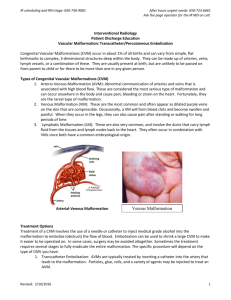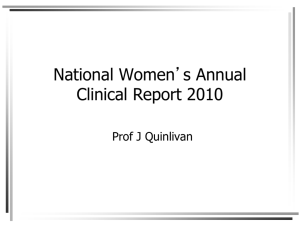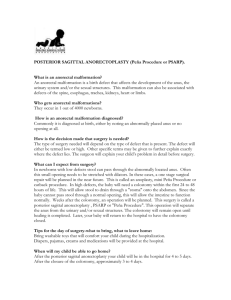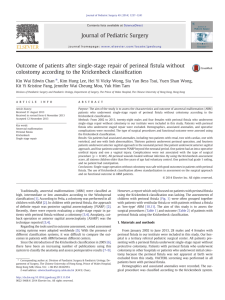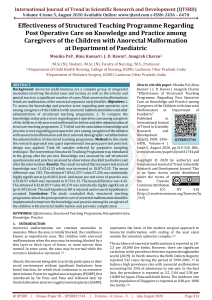a single perineal orifice: an unusual presentation of anorectal
advertisement
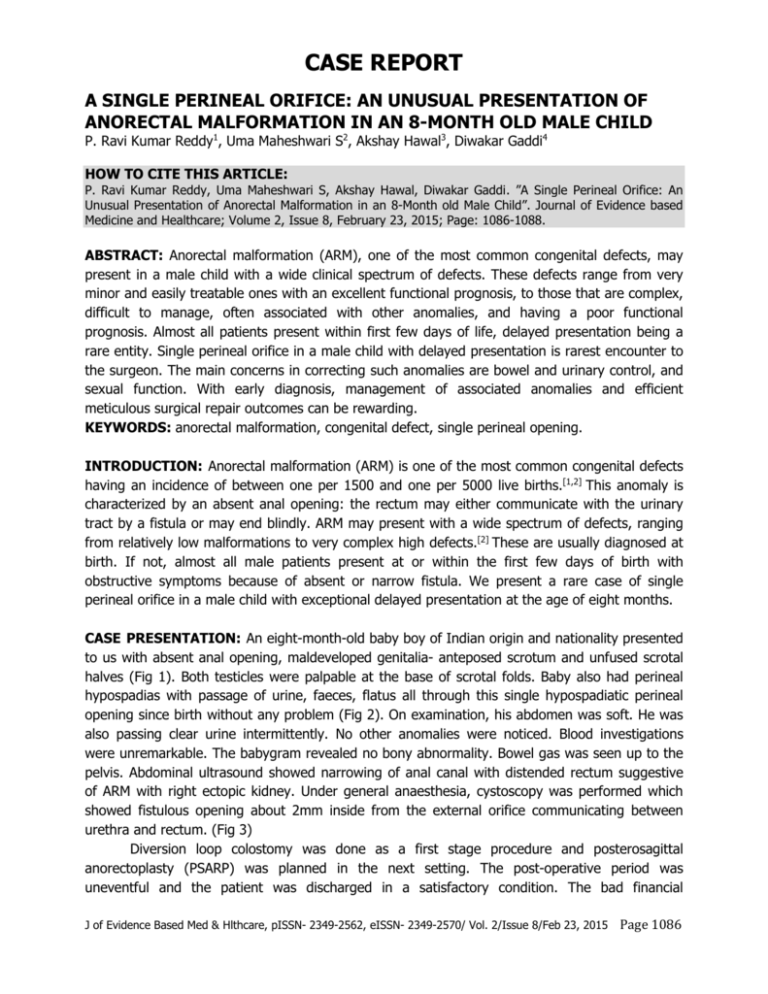
CASE REPORT A SINGLE PERINEAL ORIFICE: AN UNUSUAL PRESENTATION OF ANORECTAL MALFORMATION IN AN 8-MONTH OLD MALE CHILD P. Ravi Kumar Reddy1, Uma Maheshwari S2, Akshay Hawal3, Diwakar Gaddi4 HOW TO CITE THIS ARTICLE: P. Ravi Kumar Reddy, Uma Maheshwari S, Akshay Hawal, Diwakar Gaddi. ”A Single Perineal Orifice: An Unusual Presentation of Anorectal Malformation in an 8-Month old Male Child”. Journal of Evidence based Medicine and Healthcare; Volume 2, Issue 8, February 23, 2015; Page: 1086-1088. ABSTRACT: Anorectal malformation (ARM), one of the most common congenital defects, may present in a male child with a wide clinical spectrum of defects. These defects range from very minor and easily treatable ones with an excellent functional prognosis, to those that are complex, difficult to manage, often associated with other anomalies, and having a poor functional prognosis. Almost all patients present within first few days of life, delayed presentation being a rare entity. Single perineal orifice in a male child with delayed presentation is rarest encounter to the surgeon. The main concerns in correcting such anomalies are bowel and urinary control, and sexual function. With early diagnosis, management of associated anomalies and efficient meticulous surgical repair outcomes can be rewarding. KEYWORDS: anorectal malformation, congenital defect, single perineal opening. INTRODUCTION: Anorectal malformation (ARM) is one of the most common congenital defects having an incidence of between one per 1500 and one per 5000 live births.[1,2] This anomaly is characterized by an absent anal opening: the rectum may either communicate with the urinary tract by a fistula or may end blindly. ARM may present with a wide spectrum of defects, ranging from relatively low malformations to very complex high defects.[2] These are usually diagnosed at birth. If not, almost all male patients present at or within the first few days of birth with obstructive symptoms because of absent or narrow fistula. We present a rare case of single perineal orifice in a male child with exceptional delayed presentation at the age of eight months. CASE PRESENTATION: An eight-month-old baby boy of Indian origin and nationality presented to us with absent anal opening, maldeveloped genitalia- anteposed scrotum and unfused scrotal halves (Fig 1). Both testicles were palpable at the base of scrotal folds. Baby also had perineal hypospadias with passage of urine, faeces, flatus all through this single hypospadiatic perineal opening since birth without any problem (Fig 2). On examination, his abdomen was soft. He was also passing clear urine intermittently. No other anomalies were noticed. Blood investigations were unremarkable. The babygram revealed no bony abnormality. Bowel gas was seen up to the pelvis. Abdominal ultrasound showed narrowing of anal canal with distended rectum suggestive of ARM with right ectopic kidney. Under general anaesthesia, cystoscopy was performed which showed fistulous opening about 2mm inside from the external orifice communicating between urethra and rectum. (Fig 3) Diversion loop colostomy was done as a first stage procedure and posterosagittal anorectoplasty (PSARP) was planned in the next setting. The post-operative period was uneventful and the patient was discharged in a satisfactory condition. The bad financial J of Evidence Based Med & Hlthcare, pISSN- 2349-2562, eISSN- 2349-2570/ Vol. 2/Issue 8/Feb 23, 2015 Page 1086 CASE REPORT conditions and lack of knowledge of the family led to the delayed presentation of the child to a specialist. DISCUSSION: As mentioned previously, male patients with ARM usually present within the first few days of life due to the presence of a narrow fistulous communication between the rectum and the urinary tract, which does not allow the bowel to decompress. Although the diagnosis of ARM is made at birth, [3] the situation in our country is strikingly different, where a large number of deliveries take place at home. This may cause a delay in diagnosis as perineal examination is not a routine in the countryside. The delay in diagnosing this condition may even lead to death.[4,5] A (long-term) study noticed[3] that all patients with delayed diagnosis had low type ARM. However, this was not the case in our patient. The absence of the symptoms despite intermediate type of ARM is attributed to the wide fistulous communication between the rectum and the urinary tract. Our case is exceptionally rare. It is probably the first case of single perineal orifice being reported with such a delayed presentation at the age of eight months, the previous case being presented at 45 days of life.[6] CONCLUSION: This is an extremely uncommon case of a patient with high ARM in respect of the anatomy of malformation and the time of presentation. Patient underwent diversion loop colostomy as first stage procedure and posterosagittal anorectoplasty (PSARP) was planned in the next setting. This case also highlights the impact of financial condition, which can hinder a patient to seek treatment in a developing nation like India. ILLUSTRATIONS: Fig. 1: Maldeveloped external genitalia with anteposed scrotum Fig. 2: Single hypospadiatic perineal opening J of Evidence Based Med & Hlthcare, pISSN- 2349-2562, eISSN- 2349-2570/ Vol. 2/Issue 8/Feb 23, 2015 Page 1087 CASE REPORT Fig. 3: Pictoral representation of the anomaly REFERENCES: 1. Martucciello G: Genetics of anorectal malformation. In Anorectal malformations in children. Edited by: Holschneider AM, Hutson JM.Heidelberg Springer; 2006: 17-30. 2. Upadhyaya VD, Gangopadhyay AN, Pandey A, Kumar V, Sharma SP, Gopal SC, Gupta DK, Upadhyaya A: Single-stage repair for rectovestibular Fistula without opening the fourchette. J Pediatr Surg 2008, 43: 775-779. 3. Kim HL, Gow KW, Penner JG, Blair GK, Murphy JJ, Webber EM: presentation of low anorectal malformations beyond the neonatal period. Paediatrics 2000, 105(5): E68. 4. Haider N, Fisher R: Mortality and morbidity associated with late diagnosis of anorectal malformations in children. Surgeon 2007, 5: 327-330. 5. Lindley RM, Shawis RN, Roberts JP: Delays in the diagnosis of ano-rectal malformations are common and significantly increases serious early complications. Acta Paediatrica 2006, 95: 364-368. 6. Maletha M, Khan TR, Gupta A, Kureel SN: Presentation of high ano-rectal Malformation beyond neonatal period. Pediatr Surg Int 2009, 25: 373-375. AUTHORS: 1. P. Ravi Kumar Reddy 2. Uma Maheshwari S. 3. Akshay Hawal 4. Diwakar Gaddi PARTICULARS OF CONTRIBUTORS: 1. Assistant Professor, Department of Surgery, VIMS, Bellary. 2. Assistant Professor, Department of Medicine, VIMS, Bellary. 3. Post Graduate, Department of Surgery, VIMS, Bellary. 4. Professor, Department of Paediatrics, VIMS, Bellary. NAME ADDRESS EMAIL ID OF THE CORRESPONDING AUTHOR: Dr. P. Ravi Kumar Reddy, Assistant Professor, Department of Surgery, VIMS, Bellary. E-mail: drravireddy@gmail.com Date Date Date Date of of of of Submission: 07/02/2015. Peer Review: 18/02/2015. Acceptance: 19/02/2015. Publishing: 20/02/2015. J of Evidence Based Med & Hlthcare, pISSN- 2349-2562, eISSN- 2349-2570/ Vol. 2/Issue 8/Feb 23, 2015 Page 1088

